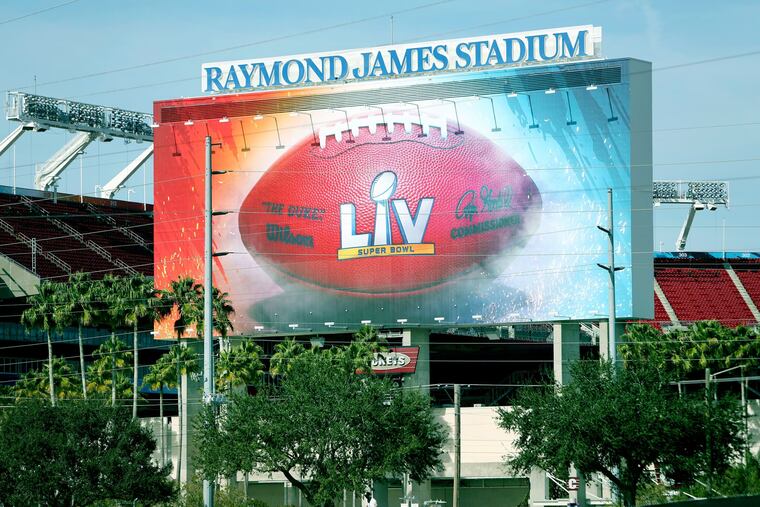NFL caps Super Bowl attendance at 22,000, including 7,500 vaccinated health-care workers
The game is scheduled for Feb. 7 at Raymond James Stadium in Tampa, Fla., which has a capacity of around 65,000, and is expandable to more than 70,000.

The NFL completed a plan, in consultation with public health authorities, to have approximately 22,000 fans attend next month’s Super Bowl in Tampa, including 14,500 ticket buyers and about 7,500 vaccinated health-care workers who will be invited as guests of the league.
The league developed its plan, officials said, by combining its regular season approach in those stadiums with fans — utilizing a seating capacity of just above 20 percent for non-vaccinated fans — with its effort to honor frontline health-care workers and promote coronavirus vaccination efforts nationwide.
“Number one, two and three is doing it safely, and we do believe that,” said Peter O’Reilly, the NFL’s executive vice president of club business and league events. “The fact that we’re able to honor and thank health-care workers and invite them as guests is something that we’re humbled and happy to do.”
The game is scheduled for Feb. 7 at Raymond James Stadium, which has a capacity of around 65,000, and is expandable to more than 70,000. Spectators are to be spaced in socially distanced seating pods. All spectators, including the vaccinated health-care workers, will be required to wear masks. All tickets for the game will be on mobile devices, a Super Bowl first.
The NFL discussed the plans with the Centers for Disease Control and Prevention and the Florida department of health. The league and Tampa’s Super Bowl host committee also worked with the six largest hospital systems in the Tampa area, comprising about 30 hospitals. The public health officials reviewed the plans and provided feedback, officials said.
“We’ve really worked closely, obviously, with our own medical experts and the CDC and all of the public health officials establishing that model, the socially distanced pods within the stadium,” O’Reilly said in a phone interview. “So that’s really based on the Super Bowl configuration of the stadium.”
NFL Commissioner Roger Goodell and other league leaders discussed the plan to invite vaccinated health-care workers to the game with team owners during a remotely conducted owners’ meeting last month.
“As we all know, these frontline workers are true American heroes and we owe them our ongoing gratitude,” Goodell said then in a conference call with reporters. “We also know that we need to rely on them for months to come to distribute vaccines and continue to treat all of those that are ill from COVID and other illnesses.”
Goodell said last month that the NFL wanted to “honor health-care workers and thank them for their extraordinary service during the pandemic and also promote the importance of vaccination.”
The NFL is providing free tickets to the vaccinated health-care workers who will attend the game. At an average ticket price of about $2,500, that represents close to $18.75 million.
Most of the invited health-care workers will come from the Tampa area. NFL officials said they expect a variety of workers, from doctors to nurses to members of hospitals’ cleaning staffs, to be represented. In addition, each NFL team other than the Tampa Bay Buccaneers will invite four vaccinated health-care workers from its market and pay for airfare and hotel costs. All of the workers chosen will have received two doses of the Pfizer-BioNTech or Moderna vaccine by Jan. 24.
Fans are to be seated mostly in pods of two or four people, with some six-person pods. Each pod will have three empty seats on each side, plus no one sitting directly in front or behind. The plan is that for each pod of non-vaccinated fans, a group of vaccinated health-care workers would be seated in the row behind, staggered to the side, throughout the stadium.
» READ MORE: Biden signs burst of executive orders tackling COVID-19, vows ‘help is on the way’
The NFL played games in empty or partially filled stadiums throughout the season, based on local health guidelines. Leaguewide attendance during the regular season and playoffs so far has been about 1.2 million fans. NFL officials have said that no coronavirus outbreaks have been traced to fans attending games. There was a leaguewide policy throughout the season of fans being required to wear masks.
For the Super Bowl, fans and staff members will be given KN95 masks upon entering the stadium, officials said.
“Our local health-care workers have worked around the clock to ensure the health and safety of our community,” Tampa Mayor Jane Castor, D, said in a written statement, “and I cannot think of a better way to honor them than with the eyes of the world on our hometown for Super Bowl LV.”
Ron DeSantis, Florida’s Republican governor, said in a written statement that he’d “like to thank the many men and women who worked hard to make this game a reality, especially our frontline health-care workers who have worked tirelessly over the past year to keep people safe.”
The NFL previously had said it was exploring a fan capacity of about 20 percent for the Super Bowl but left open the possibility of that figure being higher.
The Buccaneers play Sunday at Green Bay in the NFC championship game and could become the first team to play a Super Bowl in its home stadium.